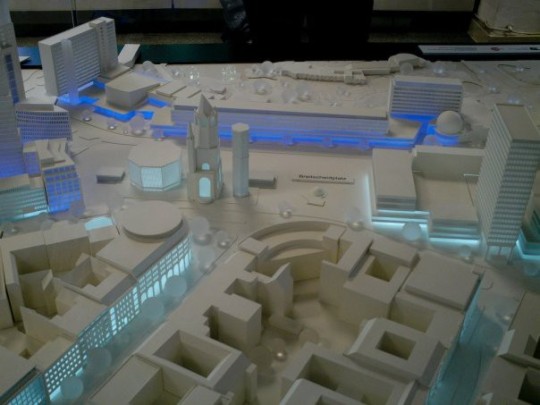Designing buildings and designing web apps have a lot in common.
By Ling Lim (Head of UX Design, myWebRoom)
This post originally appeared on Medium.
I wanted to be an architect since I was fifteen. The moment I graduated from high school, I enrolled in architecture school. I planned on doing well, to graduate with honors, to become a famous architect and to be in my love with my job.
In college, we were often given a particular topic to build a design around. The joy of working on what I was passionate about gave me a high every day. My architecture peers and I held varying opinions on things and approached every issue with a different focus. At the end of the day, that was what created the distinction among the poor, the average, the good and the best.
I was the best. My overzealous personality had worked in my favor. I graduated top of my class and my student work was nominated for a prestigious award in the UK. I felt incredibly lucky to have known what I wanted to do in life at a young age, and to then be able to live it and be exceptionally good at it. I felt unstoppable.
I was awarded a scholarship to complete my Master degree but the catch was that I had to work for the company sponsoring my education following graduation. That was when my dreams began to crack at the edges.
Suddenly, I wasn’t the best. The issues that I wanted to tackle didn’t matter. My selection of materials for what I thought was the best for the project didn’t matter. The best user experience didn’t matter very much as well. Instead, the budget mattered, the clients’ voices mattered, the authorities — its limitations and the deadlines they imposed on the project mattered.
It killed my passion a little. Being demoralized at work put me in a weird position where I wasn’t sure how to give it my best, until I realized the impact my work has because of the implicit permanence of designing a physical structure.
Lesson One: Think of Your Designs as Being Permanent Fixtures in Peoples’ Lives
There is an ugly structure sitting innocently in my hometown. My then superior revealed to me that he had designed it in his early days. The younger him did not fully realize the influence his design would have on the built environment. He shared his deep regret with me, hoping to inculcate within me a sense of responsibility in the work I put out. A huge part of it has to do with a designer’s pride. Your name is stamped on every building you design and most of the time, the building stands there permanently, or until a rich developer decides to take it down for another erection.
In product design, there is a lot of emphasis on user testing. Compared to architecture, it is much easier, quicker and cheaper to iterate on a product’s design when we receive user feedback. On the contrary, architects do not have the luxury of tearing down their designs and rebuilding them. It is true that most web designs may be ephemeral in nature but by applying this thinking, I have learnt to do more research and to put in deeper thought during the design process; this could potentially eliminate the stages of iterations that usually follow.
Don’t get me wrong. There were still plenty of creative things I enjoyed about practicing as an architect but a large chunk of it was unrelated to what made me pursue it in the first place. I thought to myself, of course one has to go through the dark times to be able to do what one truly wants to; of course I have to do all the leg work first so that maybe one day I can work for Bjarke Ingels or be (like) Bjarke Ingels. I felt a colossal amount of guilt every time I contemplated leaving the field. After all, this was what I have always wanted to do, right? How could I have been so wrong?
Lesson Two: Don’t be Afraid to “Give Up”
Just because you spent a lot of time working on something does not mean that you should do it forever. Ideas fail, things evolve and passion sometimes fade. Ten years of investment need not equate to wasting another 70 years feeling unfulfilled. Similarly, taking a leap of faith and a change in direction in your product might benefit the 2.92-billion-minus-your-product’s-existing-users internet users. Do not be afraid to be radical. You are not cheating on your past.
One summer, I finally threw in my resignation letter. Long story short, after months of backpacking in the U.S., I ended up in San Francisco. I still felt that colossal amount of guilt when I thought about changing my careers, but having had a bunch of new experiences in my arsenal, I had the strength to ignore it and to embrace an uncertain future. I sent out hundreds of job applications for creative positions. I did not know yet that it was User Experience Design I wanted to do. I just felt impulsive enough to jump without a parachute into a web of possibilities and see where I land. As a foreigner with no direct experience in UX design, I barely got any response, and when I did, it was often a rejection.
Lesson Three: Be Resilient and Relentless
Rejections? Try again. In architecture school, ideas often get torn apart during critique sessions. Many times, I have found myself completely beaten up in the wake of these sessions. Hours and hours spent on drawings and models only to have them destroyed (literally!!) by the merciless panel. But I had to bounce back. There was that, and there was quitting, and quitting was not an option.
Accept that as long as you are a designer, you will be criticized. Despite your best efforts, there will always be someone who does not know the intended button to click, someone who thinks that your designs aren’t as intuitive as the next. You will, however, never know the value of your craft until it’s out there.
During my first months living in San Francisco, I lived in an international backpacker’s hostel. It was some of the best days of my life. Living out of a suitcase and having a change of roommates every night took a toll on me but meeting people from all around the world has enriched my life in indescribable ways. Everyone was vastly different; if it was not for the hostel, we would have never connected. There was an Iranian classical composer, a Spanish waiter, the most bohemian American floral designer you would ever meet, an Irish used car salesman and then there was me. Interacting with them and every other fleeting character on my travels inevitably taught me one of the most valuable lessons I had as a designer.
Even though we got along supremely well, there were many moments when we had conflicts. These conflicts were often the result of expecting someone else to act like you would.
Lesson Four: You are Not Your Target User
As an architect, whenever we are presented with a project brief, we often have to travel to the project site for studies before starting on the design. We would sleep on site, eat by the site, breathe the air at the site and talk to the locals who are using these existing spaces. That often makes me wonder, why is it that product owners and UX professionals often start designing for a demographic without first living the problem?
How you see things usually isn’t how someone else sees things. This seems obvious enough, but honestly, it really isn’t. Upbringing, cultural differences, personal experiences, just to name a few, contribute to the whys and hows of the reasons and ways in which we do things. Common practices to me, I found out, were very often not common to people from other parts of the world. This is fundamentally the most important thing you should remember as a UX designer.
If you are planning to design a product for a certain target audience, consider traveling to that part of the world, talk to the people and immerse yourself in their culture. First hand experience with a problem has to be the best way to start designing a great product. Travel.
Lesson Five: Listen to Others
On that note, one of the main reasons I was able to get this far is simply by being open, humble and learning from others. Everyone you meet possess experiences and knowledge that you can learn from. Additionally, I believe that people are inherently kind and if you sincerely ask for help, you will often receive it.
My creative career was never meant to be linear, and yours probably isn’t as well.
Contrary to what I thought I will experience, I do not regret leaving architecture or my home country. Embarking on this wonderful adventure to discover my “true creative career” has moulded me into the designer I am today. As a lead designer who wears many hats in a young startup, I am often doing work that one may not classify as User Experience Design. Like Jonathan Shariat once famously wrote, you can’t fix the UX without fixing everything. There are lessons to be learnt about UX design everywhere you look in life.
About the guest blogger: Ling Lim was an architect in Singapore before she decided to pack her bags to explore her possibilities halfway across the world. She is now Head of UX Design at a growing startup, myWebRoom, based in San Francisco. When she is not solving problems, she enjoys powerlifting and visiting new places. Follow her on Twitter at @uxlifter.



